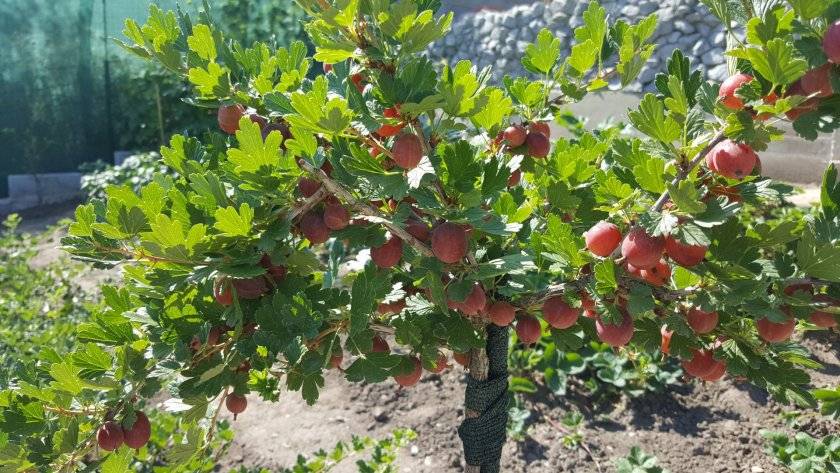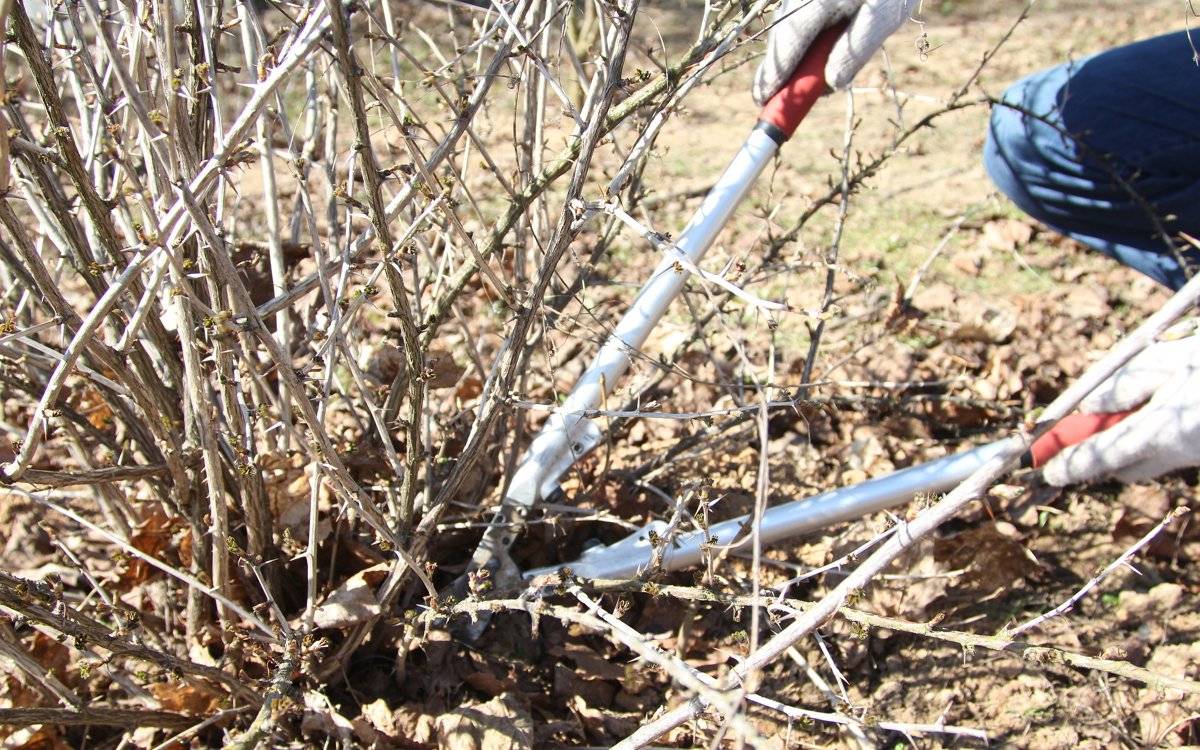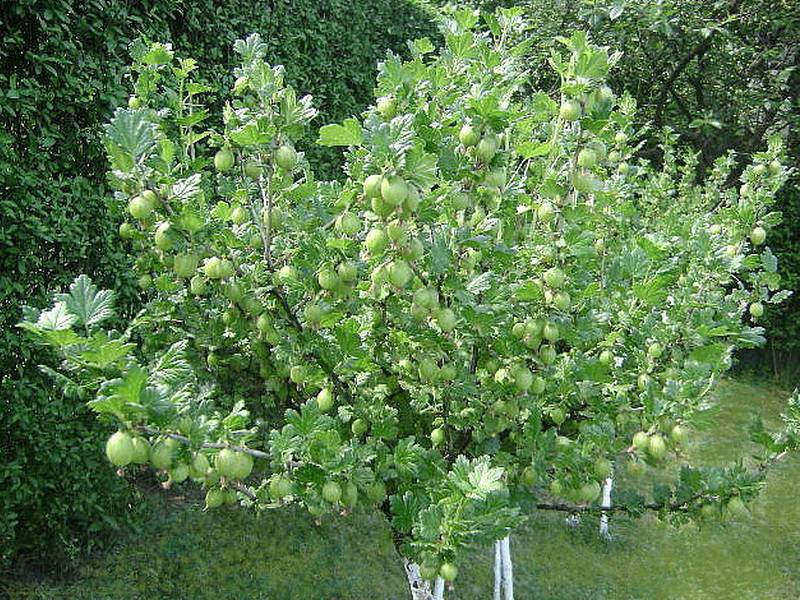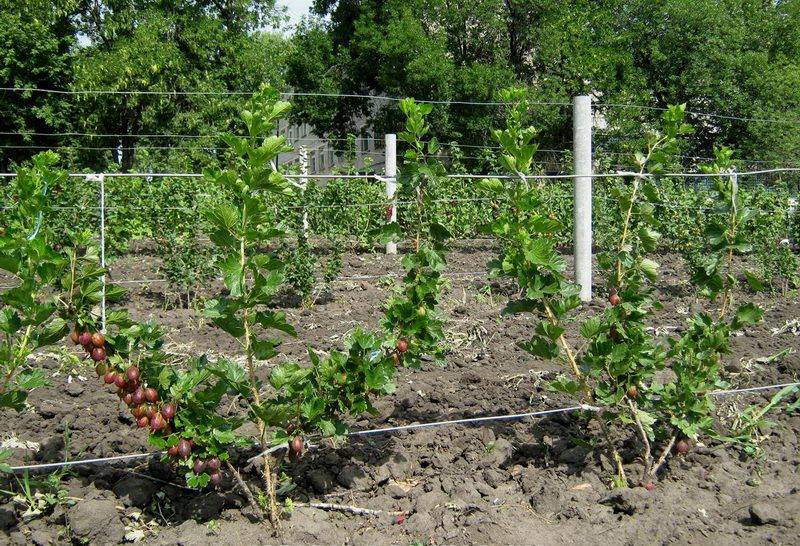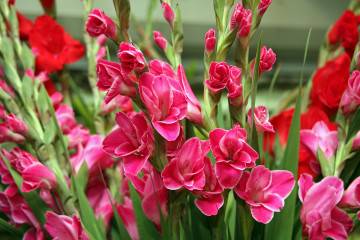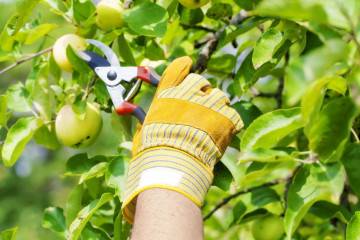Pruning gooseberries in spring, summer and fall
Content:
Any modern gooseberry variety needs regular pruning. This activity allows you to keep the shrub healthy and maintain its high yields. How to prune a gooseberry correctly depends on its age.
Why and how are gooseberries cut
By trimming the crown of a shrub, the gardener solves several important tasks at once, starting with the formation of a symmetrical neat crown, ending with an increase in yield. If the fruit crop is not pruned, its berries will shrink every year.
Reasons for pruning
Timely removal of diseased and old branches allows you to maintain an attractive appearance of the bush. Pruning excess young shoots allows the plant not to waste energy on building up green mass. All nutrients will be used to ripen the crop. Different varieties show different degrees of self-thickening, but to some extent this tendency can be traced in all.
So, the most important reasons for annual gooseberry pruning:
- Culture rejuvenation. Bushes over 8 years old are in great need of this, since their crown size exceeds the supply capacity of the root system. Removing the excess, thereby spur on the rapid growth of young shoots.
- Improved yield. Thickening of the crown leads to a deterioration in the pollination of flowers, so the amount of ovary decreases.
- Disease prevention. In a too dense crown, fungal diseases are actively developing, it is necessary to remove some of the branches for better ventilation and penetration of the sun to the berries.
- Crown formation. It is carried out in several stages so that the structure of the skeleton of the bush becomes harmonious.
Basic toolkit
If there are several bushes of different ages and sizes on the site, then in addition to the usual garden pruner, it is worth purchasing a lopper in a pair with it. Gloves should be used when working with tools so as not to injure the skin with thorns and knots. The pruner is intended for neat cutting of small twigs and young shoots that are not yet fully lignified. To thin out the crown in the thick, cut out thick and hard-to-reach branches, you will need a lopper, which has more powerful blades and handles that are much longer.
The following features will allow you to purchase a truly high-quality tool:
- Quality and durability, which must be confirmed by a well-known brand and a quality certificate.
- Good sharpening. Truly sharp tools effortlessly cut cardboard, which is easy to test in any retail environment.
- Low dead weight. It will be difficult to work in a large garden with too heavy tools.
- Rubberized or ergonomic plastic handles. The palm, even when wet, should not slip, otherwise injuries during work are inevitable.
- Bright color. A red, orange, salad-colored object is easier to see and not lose.
The correct structure of a gooseberry bush
Perennial gooseberry bushes on average reach a height of about 1.5 m.When the crown is formed correctly, its diameter is approximately equal to the height. The skeleton of the bush is formed by branches of different ages and root growth. The roots of the gooseberry and the zone at the base bear many buds, which form and wake up throughout life under favorable conditions.
From the first years of life, the bush gives many basal shoots, which at first have a green color, and then their bark turns red or brown. In autumn, all the shoots grow woody, buds of the next year are formed on them. Annual growth depends on the variety and reaches 8-30 cm. Buds and fruits are formed on the branches of the first, second and third orders, since they are the strongest and strongest. Regular pruning is the renewal and rejuvenation of the bush, helping to maintain high yields.
Gooseberry formation
How exactly pruning in spring or autumn depends on the age of the shrub. The rules for forming a gooseberry bush are the same for all varieties.
Pruning an annual bush
The first time the shrub is cut immediately after planting. Only damaged and weak branches are removed. All others are shortened, leaving 3-4 buds from the ground level.
Biennial
By the end of the season of the second year after planting, the bush should have at least 3 branches of the last year and the same number of the current one. Pruning is carried out, leaving no more than 7 shoots growing from the soil, up to 30 cm high. The branches of the 2nd order are shortened, leaving 20 cm each. All horizontal branches, whose length is less than 20 cm, are cut out completely.
Three-year
By this time, the shrub has on average up to 18 shoots of different ages, of which the crown consists. A larger number of shoots, especially root shoots, must be cut out in order to exclude too much thickening. Unviable twigs, as well as horizontally directed branches, are removed, allowing the rest of the shoots to get maximum sunlight and nutrition. The shoots left in the fall are shortened by 12-15 cm in order to get rid of their unripe part and prevent thickening with excess green mass next spring.
How to prune gooseberries in the fourth and subsequent years
From the 4th year of life, the gooseberry is considered an adult, its yield reaches the calculated value. So that it does not decrease every year, it is important to carry out regular pruning. Without a doubt, all curved and weak shoots are subject to removal. Do not leave horizontal growth, as a properly formed bush should be slightly raised above the soil level. The optimal number of branches on a gooseberry is no more than 20, and 5-year-old shoots are always removed, replacing them with strong young branches from the root growth.
After pruning, top dressing must be performed. In the near-trunk circles, a hoe or a rake is used to form a trench up to 30 cm deep, into which mineral fertilizing or compost is poured, and then added dropwise. The rate of nitrogen fertilization in the spring is 50-70 g per 1 bush. In the fall, it is useful to slightly spud the shrub with peat or compost.
Anti-aging pruning
When the bush has been bearing fruit for 7-8 years in a row, anti-aging pruning should be carried out. For this, a third of the shoots are cut out completely. This includes old twisted branches with signs of disease. Only a strong and strong root growth remains, but no more than 20 shoots.The tops of the branches are carefully examined and all unreliable ones are shortened to the first healthy bud.
Bushes over 10 years old need even more radical pruning. All branches are removed, leaving only the 5 strongest and youngest. This is done in the spring so that the gooseberry has time to grow a new crown over the summer.
Pruning a neglected bush
An extremely unfavorable scenario for any garden plant - the owner leaves it unattended and stops carrying out annual pruning. On such specimens, all kinds of pests and diseases accumulate along with the annual shoots. Neighboring landings suffer. Under such conditions, it is more advisable to remove the bush than to leave it without leaving.
If there is a desire to rejuvenate a neglected gooseberry, then the process will take 2-4 years. First, radical thinning is carried out, cutting out all broken, blackened, curved shoots, as well as those that grow horizontally. Only 5 of the strongest and youngest shoots growing from the soil are left. The tops are shortened to the first strong branch. In subsequent years, the bush is formed, adhering to standard rules.
Non-standard methods of pruning gooseberry bushes
The above rules for the formation of the crown allow you to get a bush of a standard shape. However, if desired, almost any variety can be cut differently to obtain a standard or trellis crown.
How to form a standard gooseberry
When performing annual pruning in a special way, the bush takes the form of a low tree with a trunk, which significantly saves space on the site and somewhat facilitates the process of harvesting, as well as periodic treatments from pests and diseases. As a result, the plant grows up to 1-1.5 m.Works are performed in the following sequence:
- In the first year after planting in the middle or second half of summer, only one strongest shoot is left, and the rest are cut out.
- Nearby, a vertical rigid support is dug into the soil, to which a stem is tied.
- In the second year, the crown is shortened, stimulating the growth of lateral shoots.
- In the fall, diseased and dried branches are cut out.
- In subsequent years, the root shoots are systematically cut out.
The main drawback of this method of growing gooseberries is the reduction in its lifespan to 12 years. Frost resistance also decreases, immunity suffers. The technique is recommended mainly for the southern regions.
How to prune trellis gooseberries
For ordinary plantings of spreading gooseberry bushes, the trellis technique is often used, digging strong supports at the ends of the row and pulling a wire between them, to which the shoots are then tied. Usually, 3 tiers of garters are formed at a distance of 50, 80 and 100 cm from the ground level. The step-by-step cutting sequence is as follows:
- Bushes are planted at intervals of 1 m.
- As the branches grow, they are tied to a wire.
- The root shoots are cut out.
- In the fall, the shoots of last year are shortened by a third.
- In the spring, the branches of last year are tied up in bunches of 4-5 pieces.
A valuable advantage of this method is the ease of harvesting, as well as spraying the bushes against diseases and pests. The crown is perfectly illuminated by the sun from all sides and is ventilated, the branches do not suffer when picking berries.
Seasonal pruning of the bush
It is recommended to pay attention to the formation of the gooseberry crown twice a year: in spring and autumn, and in summer - only when necessary.
Spring
Before the buds on the branches burst, perform spring pruning. This usually occurs in the first decade of March. It is enough to wait for the main snow cover to disappear. If the deadlines are missed, then you will have to postpone the work until the fall, since the harm from it now will be more than good.
Cut branches blackened and dried up during the winter. If necessary, the bush is thinned out, removing twisted, weak, broken shoots.There should not be too many thin shoots in the center, as well as vigorous branches that will not give a good harvest.
Summer
Pruning gooseberries in summer is carried out if serious damage to the plantings has occurred (after a hurricane, hail, locust infestation, etc.). They cut out everything that has suffered, since the dry branches left behind become the cause of the spread of various diseases and create a fire hazardous situation in the garden.
Autumn
If gooseberry pruning was not performed in the spring, then it is mandatory in the fall. However, you should not radically shorten the branches at this time, the work is carried out in a minimal volume, paying more attention to the removal of sick and broken branches, as well as hanging too much above the ground. It is important to renew the crown, but not overdo it. The maximum permissible volume of cut shoots is 30% of the total.
Pruning the gooseberry crown is within the power of even a novice gardener. It is enough to have a sharp instrument and a little time. Gardening done on time is the best guarantee for an excellent harvest and healthy plantings.
